Here’s a question I received on the old “Frank Answers” column at Immanuel Lutheran Church in 2013. I re-posted it as a timely issue for Earth Day on my blog in 2015. Earth Day occurs on April 22, which is also my birthday. I expand the answer here on the new Frank-Answers with some additional thoughts about Earth Day and our ongoing need for environmental awareness and action on my eightieth birthday this year.
Question: The charge has been made that Christianity is anti-environmental. In fact, there are those who blame the current environmental crisis on the Judeo-Christian tradition. Certainly some Christians have used the words of Genesis 1 about subduing the earth and having dominion over it as license to take what we need from it. Other Christians have regarded the earth as just a way station on their journey to heaven and have not felt a responsibility to take care of it. How do you answer these charges?
The question contains two somewhat contradictory assertions that level an environmental indictment against Christianity: (1) that the biblically-mandated domination of creation by humanity encourages thoughtless exploitation of the earth’s resources and (2) that the otherworldly orientation of Christianity encourages disregard for the earth.
The first indictment refers to the texts of Genesis 1:26: “Let us make man in our image, after our likeness; and let them have dominion over the fish of the sea, and over the birds of the air, and over the cattle, and over every creeping thing that creeps upon the earth,” followed by Genesis 1:29: “Be fruitful and multiply, and fill the earth and subdue it; and have dominion over the fish of the sea and over the birds of the air and over every living thing that moves upon the earth.” These “have dominion” texts, it is argued, have encouraged human exploitation of the earth’s resources and creatures.
However, the earth is not humanity’s. To the question, “Who owns the earth?”, the answer of the entire Judeo-Christian tradition is clear: “The earth is the Lord’s and the fullness thereof” (Psalm 24:1). Humankind was tasked by the Creator with stewardship—taking care of the place. In that sense, humankind was put in charge as manager. But this wasn’t a license to pollute the environment. That’s bad management. Humankind may be justly accused of poor stewardship, and this is a sin against the Creator as well as the creation. The good stewards preserve and protect what has been placed in their charge.

The second indictment points to Christianity’s otherworldly preoccupation, such as “Set your minds on things that are above, not on things that are on the earth” and “put to death whatever in you is earthly: fornication, impurity, passion, evil desire, and greed (which is idolatry)” (Colossians 3:2-5). Otherworldly preoccupation, it is argued, have caused Christians to lack concern about the environmental crisis we face today.
This text from Colossians isn’t exactly otherworldly. St. Paul is saying that we should fix our minds on heavenly things as opposed to worldly vices. The list of “earthly things” that should be “put to death” in the Colossians text are social vices, not a love of the natural world. One of those vices is greed, which has certainly contributed to the current environmental crisis, especially in the examples of strip mining and deforestration which are the most visible evidence of a thoughtless use of natural resources.

The present environmental crisis cannot be laid at the door of Christianity as such. If anything is to blame, it is the combined technological, industrial, and urban revolutions of the last several centuries—which have been centuries of increasing secularism in the developed nations of the world. People tended to take better care of the earth when they had a direct connection to it and regarded it as something sacred.
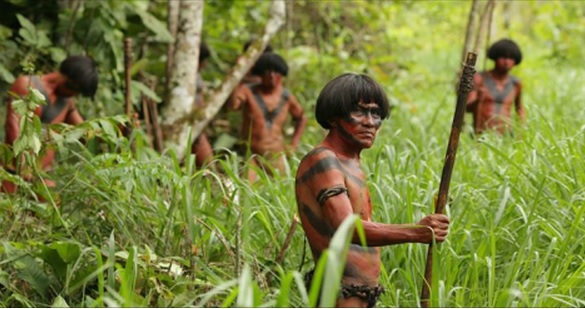
This relationship with nature was broken by industrialization and its attendant social and environmental consequences. This occurred in Western countries but also in Eastern countries; in capitalist societies and also in communist societies; in countries with a Christian heritage and also in countries with minimal Christian influence.

Air pollution in China. What species would poison the air it needs to breath in order to live?
One of the countries with the worst pollution of air, land, and water is India — the ancestral homeland of yoga! Since I am a practicing yogi I will address the relationship between yoga and the care of the earth farther down in this article.
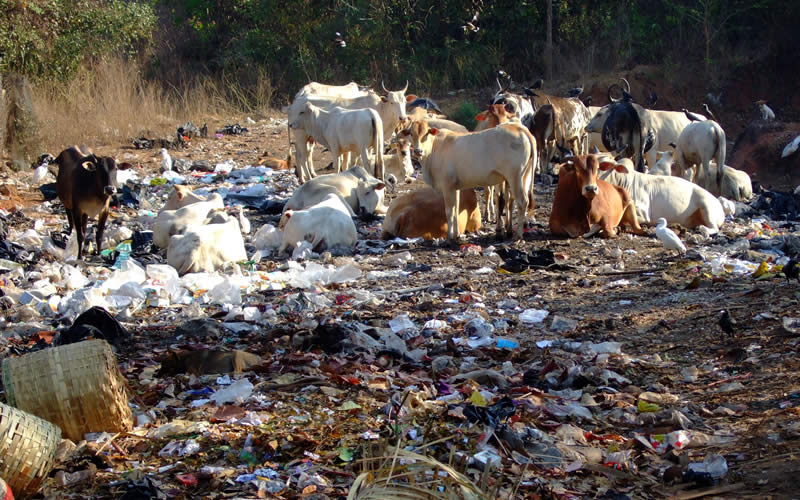
The polution of the life-giving waterways and oceans is also an ecological disaster caused mostly by humans. The Ganges, the sacred river of India, is very poluted as it makes its way from the mountains of northwest India to the Sea of Bengal. It is the river that Hindus bathe in for ritual purpose of cleansing themselves from their sins. The Naga Sadhus or naked holy ones gather along the river in the millions for the Kumbh Mela ritual every four years

Geographical Magazine Newsletter of 20 January 2022 reports:
And yet the river is being sullied by the very people who revere her. Every day, around three million litres of sewage is emptied into the Ganges – and only about half of that has undergone any kind of treatment. The river’s waters are so dirty that it’s considered one of the most polluted waterways in the world. But there’s more than just sewage entering this river; waste from tanneries, chemical plants, textile mills, slaughter houses and even hospitals is dumped, untreated, into it. Dams block and alter the river flow throughout its higher reaches. Agriculture sucks out vast quantities of water and uses it to irrigate tens of thousands of fields. Even climate change is out to get the Ganges. The monsoon rains are becoming less predictable and shorter in duration, droughts are increasing and the Himalayan glaciers that nurture the highest points are shrinking rapidly. The result is that the river levels are falling quickly.
We are of the Earth
The second creation story in Genesis 2 pictures the Lord creating Adam (the man) from the dust of the earth. Whatever is in the earth is in our bodies. So whatever else might be said about humankind, we are earthly creatures—creatures of the earth. In Gaia thought we are part of the biosphere, not separated from it. The fate of the biosphere is the fate of humanity.
We humans live in a symbiotic relationship with all life forms on Earth. Probably the most fundamental example of this relationship is that plants take in carbon dioxide and give out oxygen and we take in oxygen and give out carbon dioxide. So, yes, hug a tree. Trees and humans need each other to go on living.

Christians need to realize that our destiny is not some other world, but this one. “We await a new heaven and a new earth in which righteousness dwells” (2 Peter 3:13). The Book of Revelation pictures the heavenly city, the new Jerusalem, coming down to earth. The earth is our present home and, if Christians took their Bible seriously, it is also our eternal home. We are not made for heaven; we are made for earth. We should take delight in the home we have, feel at home in it, explore its wonders great and small, and strive to preserve it for future generations

As the earth is polluted and raped, it too looks for redemption. As the Apostle Paul wrote, “the creation was subjected to futility, not of its own will but by the will of the one who subjected it, in hope that the creation itself will be set free from its bondage to decay and obtain the freedom of the glory of the children of God” (Romans 8:21-22). As the children of God hope in the resurrection, so the whole creation longs for its renewal.
Responding to the Environmental Disaster
Earth Day is a day on which, since its first observance in 1972, we have together as a nation, and as a global community, considered the threats to our environment caused by mismanagement of Earth’s resources and developed ways of addressing the harm that has been done. But dealing with the threats that lie ahead, complicated by climate change, will require massive changes in our attitudes and way of life.
Not the least of these changes is reducing carbon emissions that are contributing to global warming. Fossil fuel burning automobiles are a major contributer to smog in urban areas and toxic atmospheres. The World Naked Bike Ride on or about June 21 is a worldwide demonstration aganst carbon-emitting vehicles. These students at the University of Maine in Bangor have a naked bike ride on Earth Day to demonstrate for the greener environment.
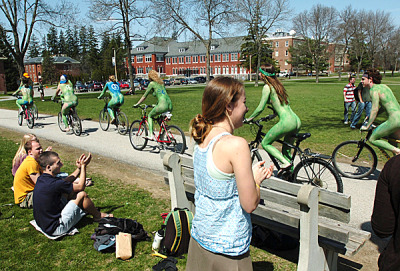
One the other side of the continent 50-70 protesters got naked and hugged trees to keep a eucalyptus grove on the University of Californis Berkeley campus from being cut down. We need more, not less, trees.
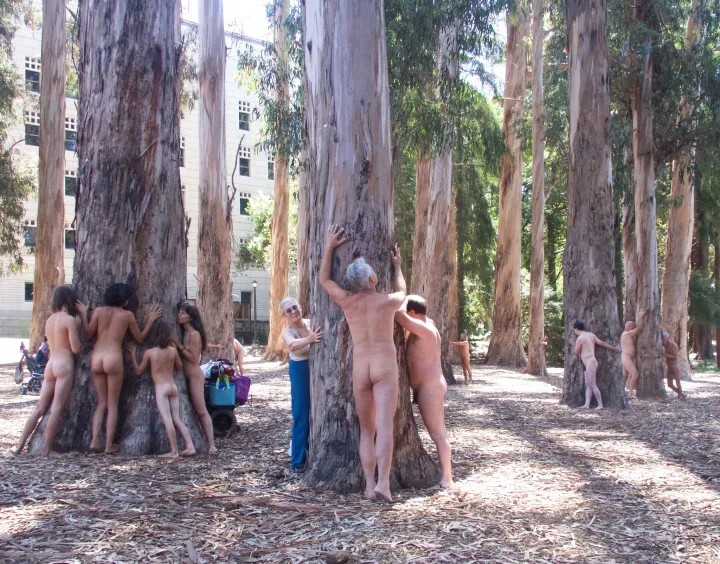
Just as Christian social ethics encourages planting signs in this world of the coming reign of God in our care of one another, so also it encourages planting signs in this world of the renewed earth. Since the first Earth Day recycling has become a way of life, people are making an effort to clean up after themselves, stores are trying to reduce their use of plastic containers, automobile emissions have been reduced, homes and businesses are trying to reduce their use of energy, there is increasing interest in renewable sources of energy, and governments are mandating cleaner ways of extracting coal and oil from the ground. There’s a long list that could be made. But three general principles would seem to be in order.
First, as the psalmist says, “The Lord is King, let the earth rejoice.” There is One who stands over the earth as its Creator, Redeemer, and Sanctifier, and the earth itself is happy and grateful for God’s rule. Christianity rejects any pantheism that regards the earth as divine; the earth cannot save itself any more than we humans can save ourselves. Creation depends on the grace of its Creator for its preservation and renewal. We are summoned to worship the Creator, not the creation. But we can behold God’s glory in the creation. As the Jesuit poet Gerard Manley Hopkins put it, “The world is charged with the grandeur of God.” To spoil the creation is to diminish God’s evident glory.
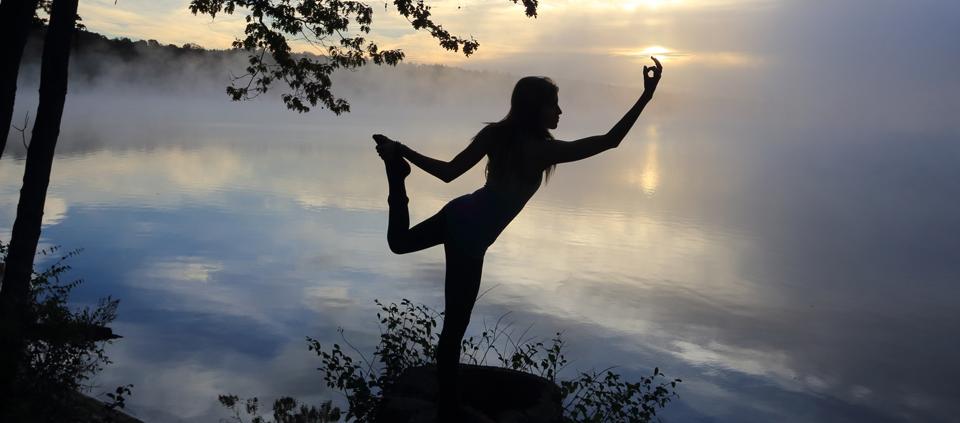
We have spoken of man as homo sapiens – “thinking humanity.” One of the consequences of the philosopher Rene Descartes’ discovery, Cogito, ergo sum (” I think, therefore, I am”), is that the mind has been disembodied. In the emerging scientific worldview our thinking mind has looked at everything, including the human body, as an object rather than as a subject with which we have a relationship. Humanity should more rightly be homo adorans — “worshiping humanity.” In adoration and praise we get out of ourselves.

Second, the agency most responsible for dealing with the environmental crisis is government because modern technology, industry, and urban life is too big to be regulated by individuals or groups. We may be subjects of a divine Ruler, but we are citizens of worldly states and our voices need to be heard in the political arenas—not because we each have all the answers but because collectively, in our deliberations, we might come up with some solutions to the environmental crisis that can be acted upon.
The late Senator Gaylord Nelson of Wisconsin is considered the father of our national Earth Day. He got involved because he saw the ecological damage that thoughtless logging in the north woods of his native Wisconsin was inflicting on the land, its people, and their economic well being. He recognized that only the federal government had the resources to create a true national framework for conservation and environmental protection; this was not something that well-funded private enterprise (which lacked the motivation) or well-meaning activism (which lacked the funding) could do on their own. Today we recognize that dealing with the environmental crisis requires the cooperation of all the governments of the world and all the world’s peoples.

The late Senator Gaylord Nelson of Wisconsin
Third, in whatever ways possible, we humans need to be reconnected with the earth. We are creatures of the earth, and earth’s fate is our fate. We need to be reconnected with the nature of which we are a part. We need to be outdoors enjoying whatever patches of nature, big or little, are available to us, so that we can appreciate the natural world of which we are a part. As Charles Eisenstein has written, “our salvation [from the ravages of climate change] must come from recovering a direct relationship to what’s alive in front of us.”

It is good for us to connect our bodies directly to Earth’s body. There’s even an electrical charge that flows from the earth into our bodies if our bodies touch the ground directly. This is called “earthing.” That’s why it is energizing to walk barefoot through the grass or along a forest path or on the beach. We need to breathe the air into our lungs, feel the breeze on our skin, sense Earth under our feet, smell the foliage around us which tickles our nostrils, hear the chirping of the birds and the rustle of the small mammals in the leaves that sends little vibrations into our ears.

While connecting with the Earth is a way of appreciating it that might motivate our care of it, Earth also has ways of caring for us. Among these is a healthy therapy called Grounding. Earth’s electro-magnetic field has electrons that can connect with the electrons of other living organisms and recharge them. Through direct contact or through perspiration-moistened animal skins used as footwear or sleeping mats, the ground’s abundant free electrons are able to enter the body, which is electrically conductive. This can help to stabilize the electrical environment of all organs, tissues, and cells.
Modern lifestyle has increasingly separated humans from the primordial flow of Earth’s electrons. For example, since the 1960s, we have increasingly worn insulating rubber or plastic soled shoes, instead of the traditional leather fashioned from hides. Obviously, we no longer sleep on the ground as we did in times past. But walking barefoot or even lying on the ground partially or fully naked can recharge our batteries. Just find a place to lay down on the ground with skin touching the surface, connecting our bodies with Earth’s body, sensing our groundedness in Earth’s electro-magnetic field, and being re-energized by it. Being grounded in Earth can give us a connection with it that strengthens our calling to take care of it as stewards (managers) of God’s garden
Yoga and Nature
With millions of people practicing yoga, yoga could be a mighty force for raising awareness of our relationship to the natural world. Teachers should find ways to get their classes outdoors, like this Earth Day class at Hays State University in Kansas.

Yoga taps into the cosmological elements of fire (sun), air (wind), earth, and water, as well as the element of space (ether), about which I have written articles on this blog. Practicing yoga naked outdoors enables us to feel these elements more directly.

Part of reconnecting with Earth is reconnecting with our own bodies. We can feel our own bodies better if we are connecting with the nature of which we are a part—feeling beneath us both the hardness and the softness of Earth that supports us in space. The body organ that relates to the sense of touch is skin. It is our most sensitive organ. It feels differences in surfaces and temperatures, textures and vibrations, dryness and wetness. In these ways we are touching Earth and Earth is touching us.

Some yoga practices relate to the five elements of earth, air, fire, water, and space (ether) in the yoga cosmology as we experience them within our bodies — the earth that grounds our practice and provides stability, the air that we breathe in as uplifting energy and exhale as we settle into our posture, the fire that transforms matter within our digestive system as we do abdominal twists, the water that flows throughout our body enabling a flowing movement from one posture to another, the space that opens up our central axis as we stretch in different directions. Yoga has sought to help students sense these elements working within our bodies.

Yoga can cultivate an “enlightened” attitude about our relationship to Earth that would encourage many of its millions of practitioners to find projects big and small that they can become a part of. Maybe one type of action yoga could undertake is for several yoga studios to have a combined outdoor class and after a concluding Earth meditation disperse everyone through the park or the beach or along rural roads to pick up trash and properly dispose of it. Earth Day’s emphasis should motivate us to give constant attention to a clean and healthy environment.

Unfortunately, even if the yoga business was of a mind to get involved in environmental projects, it lacks the organizational mechanism to engage in clean-up projects such as churches and religious groups are able to provide. Canadian yogi Matthew Remski has been a singular voice calling for more social activism from the yoga community. He has even suggested that every yoga studio should be a soup kitchen. With all due respect to Remski, who has important things to say about the real needs of modern householder yogis versus the renunciate tradition that was the basis of Patanjali’s Yoga-sutras, I don’t see modern Western yoga developing a social cohesion that would promote social or environmental activism. But what yoga can do on the basis of its long philosophic tradition is help its practitioners to recover the connection between the human body and the body of Earth, like this Indian yogi I is doing in a shape of pigeon pose.

Meditation
The relationship between our yoga practice and nature could be the subject of a meditation in the natural world while in a natural state, connecting with Earth and the whole cosmos, sensing our participation in it, and being grateful for its benefits to us humans. This exercise, repeated over time, can form in us a clearer sense of our stewardship of creation. Contemplation can lead to action. They are not mutually exclusive.

Thomas Merton, the Trappist monk of Gethsemane Abbey in Kentucky, wrote about the relationship between contemplation and action: “He who attempts to act and do things for others or for the world without deepening his own self-understanding, freedom, integrity and capacity to love will not have anything to give others.” The other could also be Earth, from which we are cut off. But that’s only in our minds. In our bodies we are part of Earth, composed of the same elements found in Earth. As Merton said (and I apply it to our relationship with Earth): “We are already one. But we imagine that we are not. And what we have to recover is our original unity. What we have to be is what we are.” We are Earth. From it we came, to it we will return. As we care for our bodies, so we care for Earth. Conversely, as we take better care of Earth, maybe we will learn to take better care of our own bodies, including what we put into them.

Stewardship
Stewardship is what the care of the earth is about—managing what has been entrusted to us. We want to pass on a clean environment to our children. But we also have a responsibility toward our fellow creatures on this planet which is home to all things living—“all creatures great and small.” God put these creatures here and therefore we have a responsibility to value them for their own sake.

There are undoubtedly community-sponsored Earth Day projects for cleaning up the environment of the mess we have made that we can participate in. We should also spend some time being quiet in some natural area and meditating on our relationship to the earth and our God-given responsibility to care for it.
Pastor Frank Senn







Outstanding! Excelente amigo. I’ll let your words be known by others in my home country.